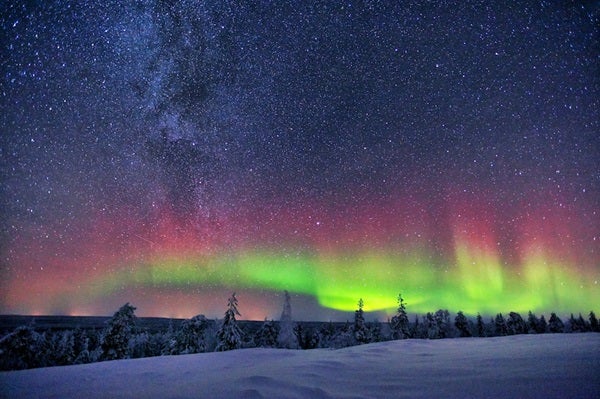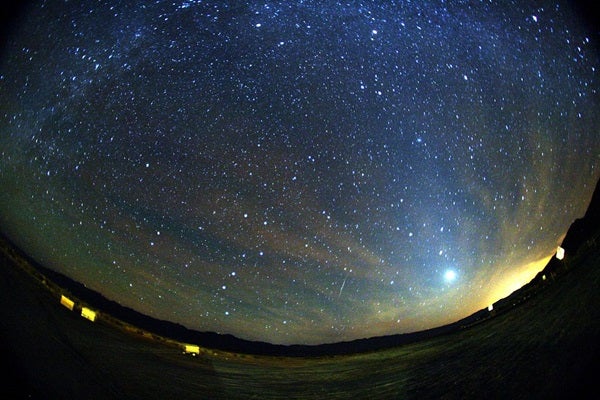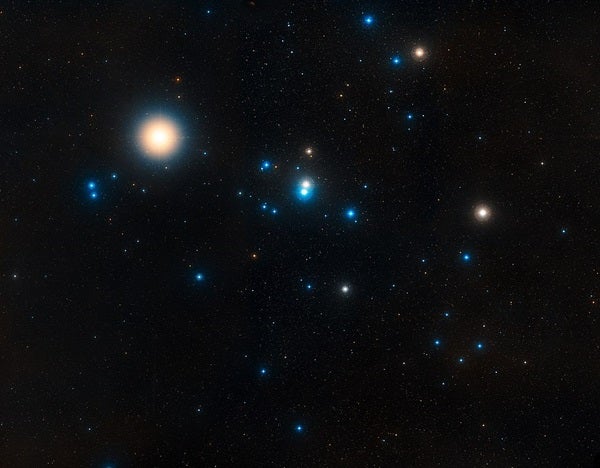The next few mornings offer a nice opportunity to view the zodiacal light. From the Northern Hemisphere, early autumn is the best time of year to observe this elusive glow before sunrise. It appears slightly fainter than the Milky Way, so you’ll need a clear moonless sky and an observing site located far from the city. Look for the cone-shaped glow, which points nearly straight up from the eastern horizon, shortly before morning twilight begins (around 5:45 a.m. local daylight time at mid-northern latitudes). The Moon returns to the predawn sky October 23, however, and its bright light will overwhelm the much fainter zodiacal light.
Saturday, October 20
The variable star Algol in Perseus reaches minimum brightness around 10:39 p.m. EDT, when it shines at magnitude 3.4. If you start tracking it this evening, you can watch it more than triple in brightness (to magnitude 2.1) by dawn. This eclipsing binary star runs through a cycle from minimum to maximum and back every 2.87 days. Algol remains visible all night, passing nearly overhead around 2 a.m. local daylight time.
Sunday, October 21
If you’re up early this morning, you should see a number of bright streaks peppering the sky. These are Orionid meteors, which belong to an annual shower that peaks before dawn. The waxing gibbous Moon sets around 4 a.m. local daylight time, leaving nearly two hours of dark skies for observers. At its peak, the shower should produce up to 20 meteors per hour radiating from the northern part of the constellation Orion the Hunter.
Asteroid hunters have a great opportunity to spot Vesta against the backdrop of Sagittarius these next two evenings. On both nights, you can find the magnitude 7.7 minor planet 0.7° north of 2nd-magnitude Sigma (σ) Sagittarii, the northernmost star in the handle of the constellation’s Teapot asterism. Use binoculars or a telescope to track down Vesta as soon as the sky grows dark.
Tuesday, October 23
Uranus reaches opposition and peak visibility tonight. Opposition officially arrives at 9 p.m. EDT, when the outer planet lies opposite the Sun in our sky. This means it rises at sunset, climbs highest in the south around 1 a.m. local daylight time, and sets at sunrise. (From 40° north latitude, Uranus peaks at an altitude of 61°, the highest it has appeared at opposition since February 1962.) The magnitude 5.7 planet lies in the southwestern corner of Aries, just over the border from Pisces. In the nights around opposition, you can find it 2.8° northeast of 4th-magnitude Omicron (ο) Piscium. Although Uranus shines brightly enough to glimpse with the naked eye under a dark sky, use binoculars to locate it initially. A telescope reveals the planet’s blue-green disk, which spans 3.7″.
Wednesday, October 24
Full Moon officially arrives at 12:45 p.m. EDT, but it should look completely illuminated all night. You can find it rising in the east around sunset and peaking in the south around 1 a.m. local daylight time. It dips low in the west by the time morning twilight starts to paint the sky. The Moon resides in the northern part of the constellation Cetus. October’s Full Moon also goes by the name “Hunter’s Moon.” In early autumn, the Full Moon rises about a half-hour later each night compared with a normal lag close to 50 minutes. The added early evening illumination supposedly helps hunters track down their prey.
Saturn continues to be a standout object in the early evening sky. The ringed planet stands about 20° above the southwestern horizon an hour after sunset and remains on view until nearly 10 p.m. local daylight time. The ringed planet shines at magnitude 0.5, more than a full magnitude brighter than any of the background stars in its host constellation, Sagittarius. If you own a telescope, there’s no better target than Saturn. Even the smallest instrument shows Saturn’s 16″-diameter disk surrounded by a dramatic ring system that spans 36″ and tilts 26° to our line of sight.
Friday, October 26
The waning gibbous Moon rises in the east around 8 p.m. local daylight time. Wait about an hour for it to climb well clear of the horizon and you’ll see it perched just west of the Hyades star cluster in the constellation Taurus the Bull. Binoculars will deliver the best views of this pretty conjunction. If you keep watching throughout the night, you’ll see the Moon pass in front of the V-shaped Hyades.
Venus reaches inferior conjunction at 10 a.m. EDT. This position places the inner planet most nearly between Earth and the Sun (precisely 6° south-southwest of our star), so it is lost in the glare. But the brilliant world orbits the Sun quickly, and it will return to view before dawn in about 10 days.
This week offers evening skywatchers a final chance to see Jupiter before it disappears in the Sun’s glow. Use binoculars to locate the giant planet some 6° above the southwestern horizon 30 minutes after sunset. Jupiter shines brightly at magnitude –1.7 and should stand out if you have a clear and unobstructed horizon. As a bonus, you might also catch a glimpse of Mercury. The innermost planet lies 3.4° (about half a binocular field) below Jupiter. At magnitude –0.2, Mercury appears about one-quarter as bright as its companion.
Sunday, October 28
Mars continues to put on a great show these October evenings. The Red Planet appears more than 30° above the southern horizon once darkness falls. The world shines at magnitude –0.7, significantly brighter than any star visible on October evenings, against the faint backdrop of Capricornus. A telescope reveals a disk that spans 12″ and shows several subtle surface features.












